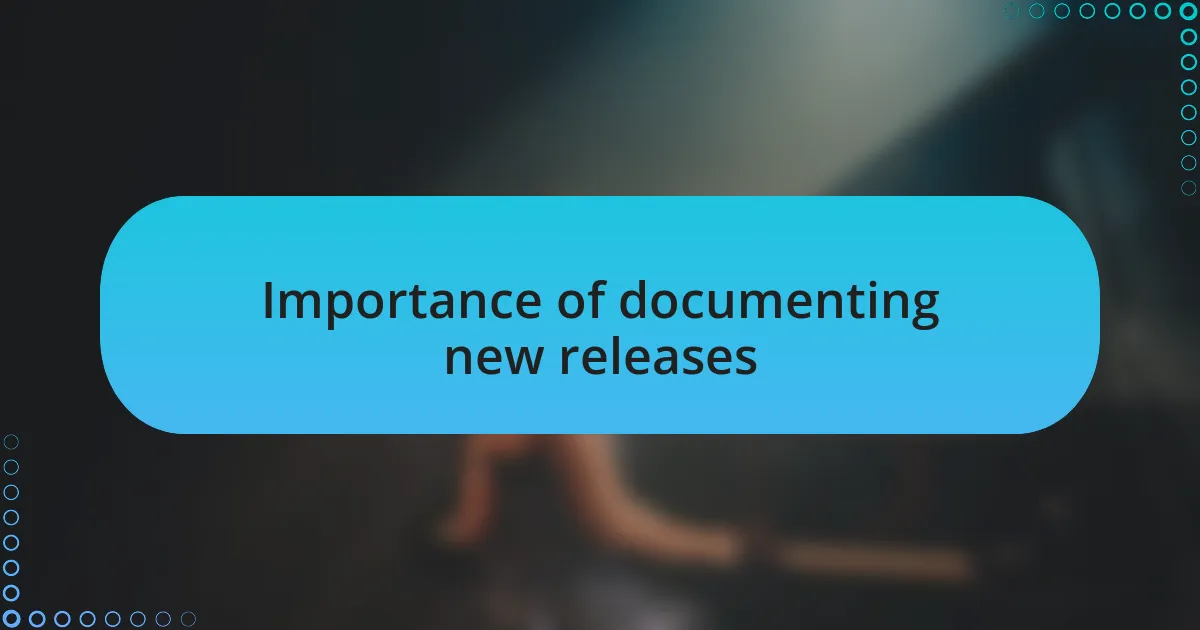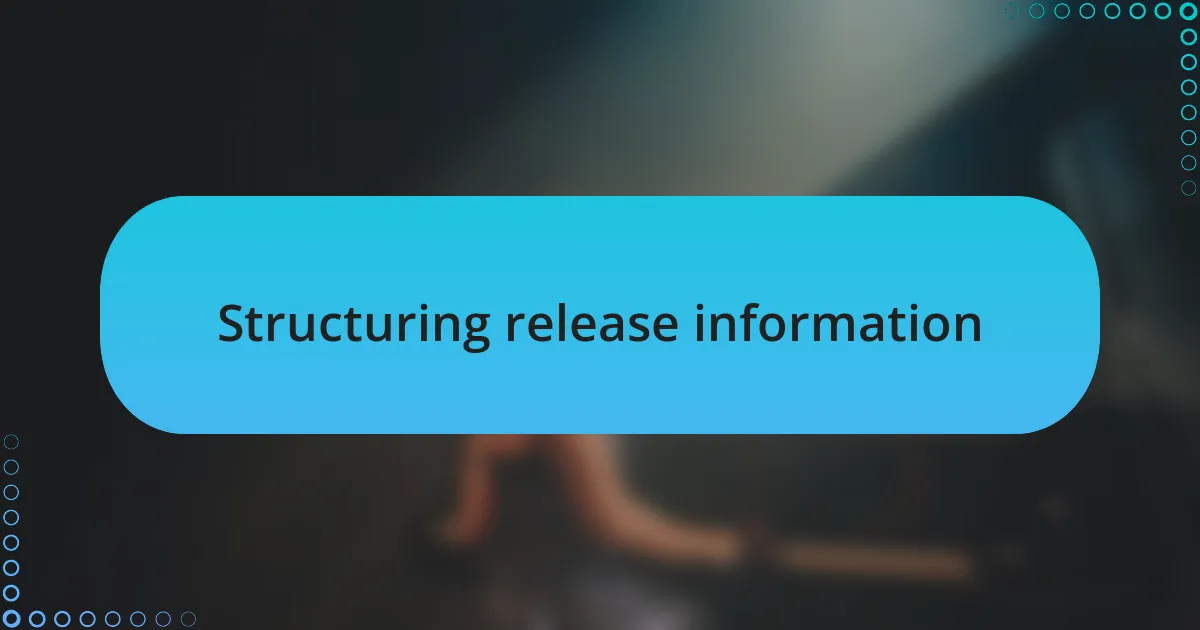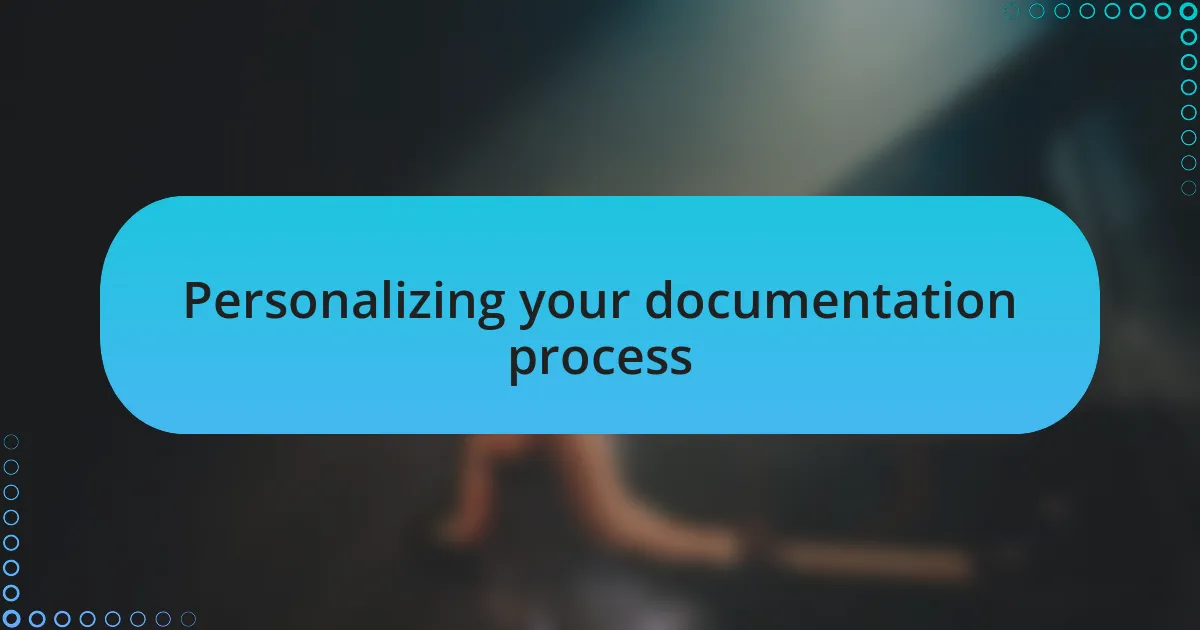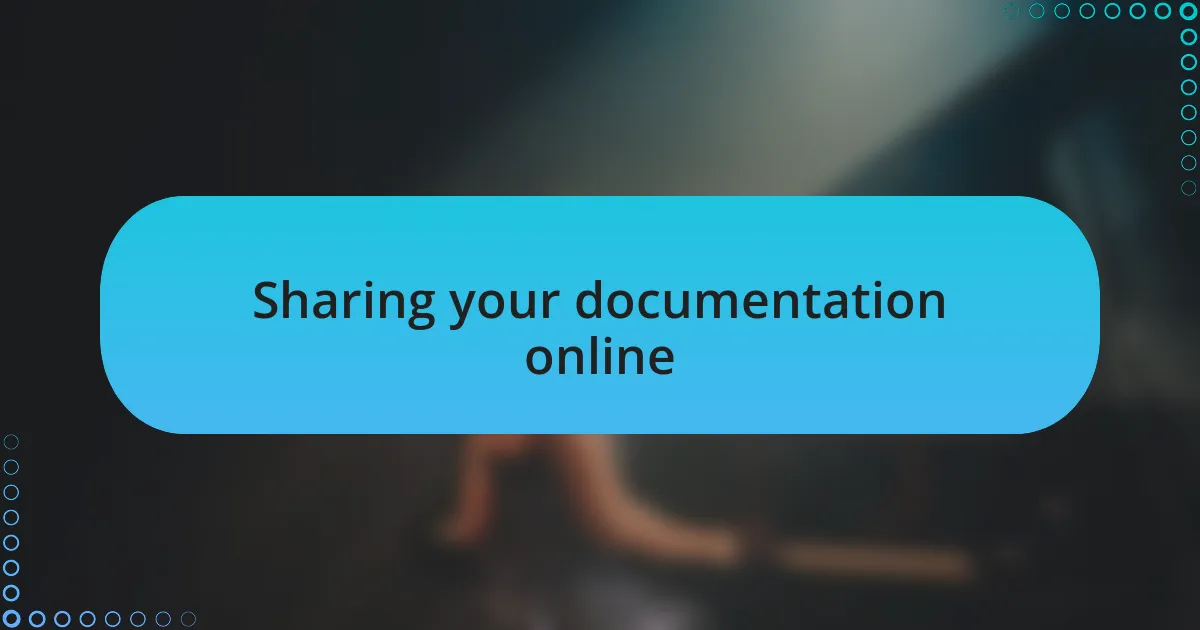Key takeaways:
- Clear documentation of new music releases fosters a deeper connection between the band and its audience, enhancing engagement and marketing effectiveness.
- Utilizing tools like music management software, content calendars, and collaboration platforms streamlines the documentation process and promotes teamwork.
- Personalizing the documentation with unique storytelling and interactive elements transforms the audience’s experience and involvement with the band’s creative journey.

Understanding new release documentation
Understanding new release documentation is essential for any music band looking to keep their audience engaged. When I first started tracking new releases, I found myself overwhelmed by the sheer volume of information available. How do you sift through it all and still find what truly matters?
I remember a time when I missed out on promoting a significant release simply because I overlooked the details hidden in complex documentation. I soon realized that clarity is key. It’s about summarizing essential points and ensuring that the narrative of the release resonates with your audience. Have you ever felt that rush when a new album drops? That excitement is what I aimed to capture in my documentation, knowing it could influence how fans perceive and connect with the band’s journey.
The way a new release is documented can transform a simple announcement into a compelling story. For me, it became a ritual: diving deep into the themes, the inspiration behind the music, and even the emotions expressed in the lyrics. Isn’t it fascinating how the right words can evoke feelings and draw listeners in? As I honed my documentation process, I discovered that the details not only matter—they can elevate an entire release, turning it into a memorable experience for fans.

Importance of documenting new releases
Documenting new releases is crucial because it serves as a bridge between the band and its audience. I’ve often found that when I articulate the story behind a release, people connect more deeply with the music. Think about it: aren’t we all more drawn to songs that resonate with our experiences or emotions? That context can make all the difference.
I’ve learned that clear documentation can also enhance marketing strategies. When I published a detailed piece about an upcoming single, I saw a spike in engagement from fans eager to share it on social media. How can you prepare for a launch without a narrative that captures interest? It’s in these moments that I truly appreciate the importance of emphasizing not just the music, but the journey and intention behind it.
Moreover, effective documentation has this magical ability to preserve a band’s legacy. Reflecting on the new album releases I’ve meticulously documented, I realize that they become part of the band’s history. How often do we look back at old interviews or news articles and feel transported to that moment? When done right, each release documentation piece can become an archive of creativity and emotion, inviting fans to relive those experiences over and over again.

Tools for documenting music releases
When it comes to documenting music releases, I find that using dedicated music management software can be an invaluable asset. For example, I once utilized a platform designed specifically for artists, and it allowed me not only to track release dates but also to document band member contributions, album artwork, and even fan feedback. It felt like creating a living history of our music, enabling us to see how the narrative evolved over time.
Another essential tool I often turn to is a content calendar, which helps keep everything organized. I remember the chaos of a surprise single drop, and without my calendar, details would have slipped through the cracks. How can we engage our audience effectively if we don’t have a solid plan? Juggling release dates, social media posts, and promotional activities requires a clear roadmap, and a well-structured calendar provides just that.
Finally, I can’t stress enough the importance of collaboration tools for gathering insights from the entire band. I once encouraged my bandmates to share their thoughts and stories in a shared document, and the result was eye-opening. It not only captured various perspectives but also made each release feel like a collective endeavor. Have you ever noticed how powerful it is when all voices come together? That sense of unity can transform how we document and present our music to the world.

Creating a release schedule
Creating a release schedule is crucial for maintaining momentum and ensuring that each release gets the attention it deserves. I recall one instance where I misjudged the timing of a single drop, thinking our fans would be eagerly awaiting it. Instead, it was lost in the shuffle of holiday distractions, teaching me the hard way that knowing when to share can be just as important as what we’re sharing.
When building a release schedule, I always emphasize balancing creativity with organization. I’ve found that allocating specific timeframes for recording, mixing, and promotion not only keeps our projects on track but also helps prevent the stress of last-minute scrambles. How do you decide when to unveil your music? It’s about creating a rhythm that aligns with both our creative flow and our audience’s expectations.
I also recommend regularly revisiting the schedule to allow for adjustments based on feedback or unexpected challenges. During one of our album launches, we had to shift a release date because of overlapping commitments with a charity event. That flexibility made our project even stronger. Have you considered how external factors might influence your release timeline? Life happens, and being adaptable can enhance both the journey and the end product.

Structuring release information
When structuring release information, clarity is paramount. I’ve found that breaking down the details helps both the band and the fans to engage effectively. For example, I like to include a brief synopsis of the release, which not only captures the essence of the music but also gives context for its significance. Have you ever seen a post that left you scratching your head? That’s exactly what I try to avoid.
I also value the importance of providing a timeline for each phase of the release. In one of our recent projects, I included specific dates for teasers, previews, and the official launch. This transparency built anticipation among our fans and kept everyone in the loop. It’s a great way to keep the excitement bubbling—have you thought about how a simple timeline can transform the way your audience connects with your music?
Lastly, I prioritize including links and resources that fans can use to access the new releases. During a launch, I once shared a behind-the-scenes video that offered a more personal look into our creative process. The response was overwhelming; fans loved feeling included in our journey! It’s moments like these that reinforce the connection between our music and our audience, making every release feel like a shared experience. What innovative ways have you used to connect your audience with your music?

Personalizing your documentation process
When it comes to personalizing your documentation process, I believe it’s all about capturing your unique voice as a band. I once experimented with adding a storytelling element to our documentation, sharing the inspiration behind a song’s lyrics. It not only built a deeper emotional connection with our fans but also made them feel like they were part of our creative journey. Have you considered how sharing personal anecdotes can turn a simple release into a memorable experience for your audience?
Another strategy I’ve adopted is customizing the format of the documentation to fit the personality of the band. In one of my projects, I used vibrant visuals accompanied by playful language to match the upbeat style of our latest album. Fans often commented on how much they appreciated the lively presentation, which made the information more accessible and engaging. Isn’t it fascinating how the right style can capture the essence of your music?
Finally, I find that receiving feedback from fans is an essential part of personalization. After a recent release, I encouraged our audience to share their thoughts and questions, which led to a Q&A session online. This interaction not only provided valuable insights but also made our fans feel heard and valued. How often do you reach out to your community? Engaging with fans in this way can truly transform your documentation process, making it a dialogue rather than a monologue.

Sharing your documentation online
Sharing documentation online opens up exciting avenues for interaction and connection. During one of our album launches, I chose to share behind-the-scenes videos documenting our recording process. Fans flooded our social media with comments, eager to see the creative chaos that led to their favorite tracks. It was incredible to witness how this glimpse into our world sparked conversations that deepened their connection to our music. Have you ever thought about how sharing these moments could transform your audience’s perspective?
Moreover, I’ve found that utilizing various online platforms allows you to tailor your documentation to fit different audiences. For example, I once created a blog series around our tour experiences, complementing it with a dedicated Instagram story highlight to catch the eye of followers who prefer bite-sized content. The mix not only increased engagement but also ensured that each fan could interact with our documentation in a way that resonated with them. Isn’t it empowering to know that you can reach fans where they are most comfortable?
Lastly, I often suggest integrating interactive elements into your shared documentation. In one instance, I invited fans to submit their interpretations of our latest song. The creative artwork and stories that came back surprised and delighted us, breathing new life into our release. This kind of shared experience does more than just showcase your work—it cultivates a collaborative spirit that makes fans feel like they are an integral part of your journey. When was the last time you involved your audience in your creative process?